A Different Kind of Flame – Indian Oil Lamps
PRIMITIVE - Friday, December 18, 2015By Misaki Imagawa
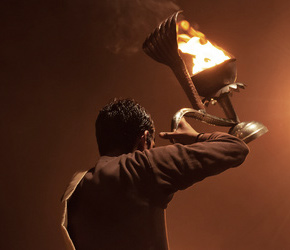 |
|
Can you imagine a world in which humankind never learned to create fire? It would be an altogether different place, perhaps in ways we cannot imagine. What need drove humankind to harness fire? Perhaps it was the need to cook, provide heat or for protection; but maybe it was the simple need to illuminate the darkness. After all, fire was the only source of light until the electric light bulb was invented in the 19th century; yet, even with the advent of electric light the use of firelight did not disappear. Despite the march of progress, the use of firelight provided by oil lamps remained steady, particularly in India. Could this be because the flames they provided did more than produce light? A flickering flame can be engaging, mesmerizing and even inspirational. Flames can induce trances and cause visions, negate destructive forces and spiritually cleanse. They can symbolize myths, deities and the birth of the universe itself. So it is no wonder that oil lamps continued to be useful, decorative and meaningful accessories even after light became dominated by electricity.
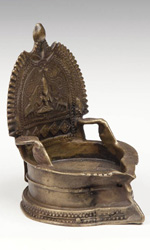 |
|
|
|
Many cultures still use firelight for religious and cultural ceremonies – not because firelight is bright, but because it represents something a light bulb never can: a deep spiritual dimension. This is precisely the case among practitioners of all the world’s religions, but none more so than Hindus who have been using oil lamps ceremonially for thousands of years. In their oldest form, oil lamps were used to transport fire in a manner that was far safer than a flaming torch, yet still bright enough to light the way. The first such oil lamps were simple concave vessels such as sea shells, coconuts and carved stones that could contain oil or animal fat and a wick that would prolong the burning of the flame. In India, oil lamps emerged sometime during the Vedic period (1500-500 BCE) and since then have been an integral part of Indian life.
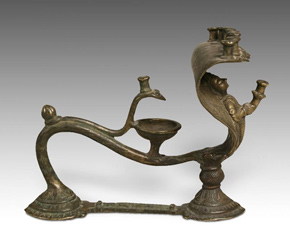 |
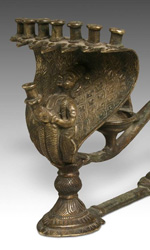 |
|
Deepak or diya is Sanskrit for ‘oil lamps,’ which are lit not only during festivals but for everyday worship in homes all over India. Stated simply, an oil lamp can be called a deepak. Some families light deepak to mark specific day parts; for example, at dawn, dusk or even both. Some households believe the light of the deepak in the shrine should be the first light at night, lit before any other lights are turned on. Others keep lamps burning continuously at all hours of the day in a practice called Akhanda Deepa. This custom stems from the belief that light is knowledge, knowledge is power, and together they vanquish darkness, or ignorance. Just as many flames can be lit from a single deepak without diminishing its brightness, knowledge can also be shared without being lost. Oil lamps are therefore considered auspicious symbols of knowledge, goodness and abundance.
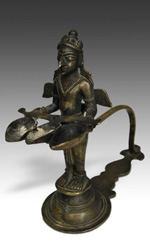 |
|
In Hinduism, the Goddess Rajarajeshwari is often associated with the oil lamp. Some devotees believe she resides within the lamp. This goddess is the combined form of Saraswati, Lakshmi and Durga, the goddesses of wisdom, wealth and feminine power. They are the three consorts of the gods Brahma, Vishnu and Shiva, collectively known as the Hindu Triad, the gods of creation, preservation, and destruction. Together they comprise the circle of life. Consequently, Rajarajeshwari is attributed with the powers of creation, preservation and destruction and is considered one of the most powerful forms of Shakhti, the primordial cosmic energy. In turn, the deepak came to be treated as a sacred object and no ritual, prayer or festival can begin without it being lit.
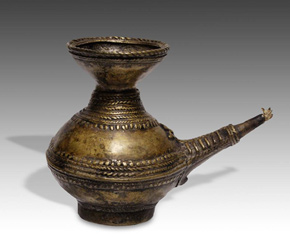 |
|
There are several different forms of oil lamps, from the traditional round or pear-shaped dish to ones with intricate styles and figures. Although oil lamps may be composed of stone or clay, many are cast using lost-wax methodology and composed of various metals including brass and bronze. Often, these lamps are decorated with elaborate designs, auspicious motifs or deities. The Goddess Lakshmi is particularly popular due to her connection with Diwali, the festival of light, which celebrates the victory of light over darkness, or good over evil. The third and most festive day of Diwali is dedicated to Lakshmi, who represents both material and spiritual wealth. Oil lamps depicting Lakshmi are called Deepalakshmi; however, other auspicious deities such as Ganesh and Garuda are also traditionally portrayed.
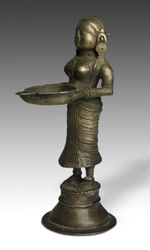 |
|
Deepalakshmi forms first emerged in the early 17th century, but oil lamps in the shape of women holding vessels in their hands are a far older tradition. Called Paavai vilakku, these types of deepak can be small to almost life-size; the largest and most intricate are often found in temples. Another time-honored style of lamp is the Thookku vilakku, which is suspended by chains from the roofs and ceilings of temples, verandas and home puja (prayer) rooms. Although deepaks used for ceremonies are typically more elaborate and may display elaborate decoration and holders for multiple wicks, household oil lamps can be just as embellished. On the other hand, sometimes the most auspicious and important can be the most minimal in design. After all, it was the symbolism within the oil and wick that was important. Hindus believe the oil represents negative vasanas, or desires, and the wick represents ego. When the wick is lit with knowledge, both negativity and ego slowly perish, allowing a person to reach a higher spiritual plain.
Rich tales of oil lamps exist throughout cultures found all over the world – extending far beyond India – from Ancient Rome to China to the Arab world. In fact, in the wish-granting genie in a bottle stories, the 'bottle' is actually a medieval Arabian oil lamp. As objects of function, art and spiritual significance, oil lamps have illuminated the footsteps of human history. Today, they light up our homes, dreams, and of course, the festive holiday season.
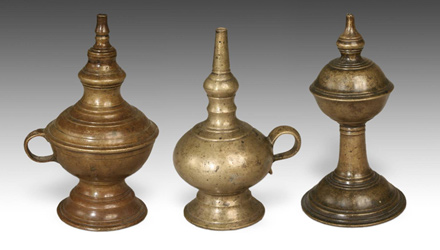 |
Download this Article: A Different Kind of Flame - Indian Oil Lamps.pdf